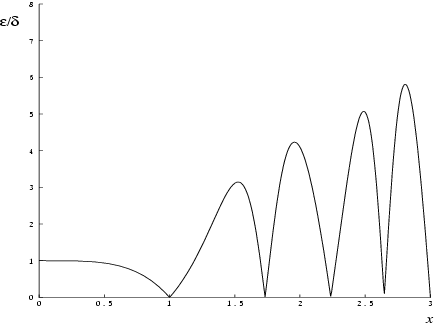s20ad returns a value for the Fresnel integral .
 Syntax
Syntax
| C# |
|---|
public static double s20ad( double x ) |
| Visual Basic |
|---|
Public Shared Function s20ad ( _ x As Double _ ) As Double |
| Visual C++ |
|---|
public: static double s20ad( double x ) |
| F# |
|---|
static member s20ad : x : float -> float |
Parameters
- x
- Type: System..::..DoubleOn entry: the argument of the function.
Return Value
s20ad returns a value for the Fresnel integral .
 Description
Description
s20ad evaluates an approximation to the Fresnel integral
Note: , so the approximation need only consider .
The method is based on three Chebyshev expansions:
For ,
For ,
where ,
and ,
with .
For small , . This approximation is used when is sufficiently small for the result to be correct to machine precision.
For large , and . Therefore for moderately large , when is negligible compared with , the second term in the approximation for may be dropped. For very large , when becomes negligible, . However there will be considerable difficulties in calculating accurately before this final limiting value can be used. Since is periodic, its value is essentially determined by the fractional part of . If , where is an integer and , then depends on and on modulo . By exploiting this fact, it is possible to retain some significance in the calculation of either all the way to the very large limit, or at least until the integer part of is equal to the maximum integer allowed on the machine.
 References
References
Abramowitz M and Stegun I A (1972) Handbook of Mathematical Functions (3rd Edition) Dover Publications
 Error Indicators and Warnings
Error Indicators and Warnings
There are no failure exits from s20ad. The parameter _ifail has been included for consistency with other methods in this chapter.
 Accuracy
Accuracy
Let and be the relative errors in the argument and result respectively.
If is somewhat larger than the machine precision (i.e if is due to data errors etc.), then and are approximately related by:
Figure 1 shows the behaviour of the error amplification factor
.
However, if is of the same order as the machine precision, then rounding errors could make slightly larger than the above relation predicts.
For small , and there is no amplification of relative error.
For moderately large values of ,
and the result will be subject to increasingly large amplification of errors. However the above relation breaks down for large values of (i.e., when is of the order of the machine precision); in this region the relative error in the result is essentially bounded by .
Hence the effects of error amplification are limited and at worst the relative error loss should not exceed half the possible number of significant figures.
 Parallelism and Performance
Parallelism and Performance
None.
 Further Comments
Further Comments
None.
 Example
Example
This example reads values of the argument from a file, evaluates the function at each value of and prints the results.
Example program (C#): s20ade.cs
